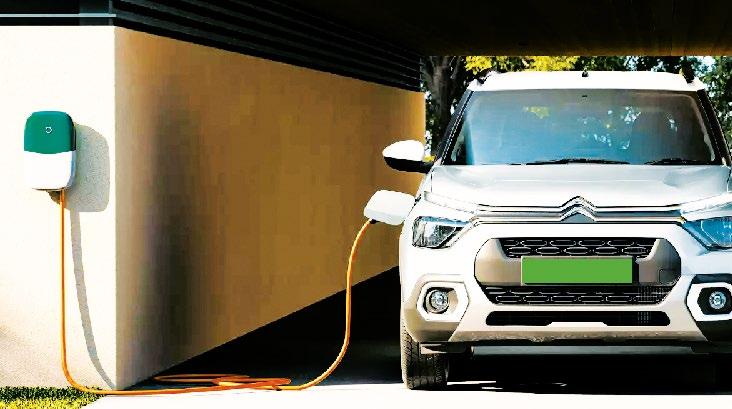
3 minute read
ACHIEVEMENTS IN RENEWABLES STRENGTHENED RESOLVE FOR
NET ZERO BY 2070: PRESIDENT
President Droupadi Murmu said India has achieved the target of making 40 per cent of its electricity generation capacity from non-fossil fuel sources, a success that has strengthened the resolve to achieve Net Zero by 2070.
Advertisement
In her maiden address to the joint sitting of Parliament marking the beginning of the Budget Session, Murmu said India was also progressing rapidly towards achieving the target of 20 per cent ethanol blending in petrol. “India has also changed the perception, which considers progress and nature as contradictory,” she said addressing lawmakers in the Central Hall of Parliament. She said the government has increased the solar power capacity by almost 20 times in the last eight years and India now ranks fourth in the world in renewable energy capacity. “My government is focusing on green growth and is emphasizing on connecting the entire world with Mission LiFE,” Murmu said.
Prime Minister Narendra Modi had announced Mission LiFE at the climate conference in Glasgow in 2021 urging nations to replace the prevalent ‘use and dispose’ economy with a circular economy defined by mindful and deliberate utilisation.
Net Zero refers to cutting greenhouse gas emissions to as close to zero as possible. India has committed to achieve Net Zero by 2070. Murmu said her government has also approved the Hydrogen Mission which was going to attract investment worth lakhs of crores of rupees in India in the field of green energy. “This will result in reducing our dependence on foreign countries for clean energy and also for energy security,” she said. The President said reducing pollution in cities was also the top priority of her government and work was underway on a very large scale for electric mobility. “Under the FAME (Faster Adoption and Manufacturing of Electric Vehicles) scheme, more than 7,000 electric buses are being added to public transport by the central government in many cities of the country, including the capital city of Delhi. In the last eight years, metro network in the country has increased more than three times,” she said.
Murmu noted that metro projects were underway in 27 cities and more than 100 new waterways were also being developed across the country. “These new waterways will help transform the transport sector in the country,” she said.
Murmu said her government has constantly laid unprecedented emphasis on innovation and entrepreneurship. “This is harnessing the strength of our country with the world’s youngest population. Today our youth are demonstrating the power of their innovation to the world,” she said. “In 2015, India was ranked 81st in the Global Innovation Index. Now it has reached the 40th position. Seven years earlier, there were only a few hundred registered start-ups in India, today this number is almost 90,000,” Murmu said.
Source: PTI
India Needs Accelerated Support For Electric Vehicles To Achieve Net Zero

The recent Auto Expo 2023, India's largest motor show, generated significant excitement with the launch of several low- and zero-emission vehicle models, including electric vehicles (EVs), hydrogen, and hybrids. While the event confirmed the auto industry’s growing focus on decarbonization, it also showed that India urgently needs to accelerate budgetary support for zero-emission technologies—particularly EVs, as the most mature and commercially viable segment in the transport sector.
The fact is that decarbonizing the transport sector will be essential for India’s clean energy transition and its journey to achieve net-zero emissions by 2070. EVs are the key technology in this process. Although more and more people across India are adopting EVs, they still comprise a marginal component of all new sales. EVs share in total vehicle sales grew from 1.7% in 2021 to 4.7% in 2022, driven by faster adoption in the two-wheeler and three-wheeler segments. Boosting government spending and adopting favorable policies is therefore crucial to truly unlock the country’s electric mobility potential.
A recent study by the International Institute for Sustainable Development (IISD) and its partners showed that the uptake of subsidies for EVs remains the lowest across energy technologies. Although EV subsidies rose around three times between 2021 and 2022—driven by a concessional Goods & Services Tax (GST) rate on EVs and the FAME-II scheme that supports the electrification of public and shared transportation—they accounted for only 1% of India’s total energy subsidies. Policymakers need to significantly increase spending to support the creation of charging infrastructure across the country, extend the FAME-II scheme’s duration beyond 2024, secure critical mineral supply chains in the medium-term, and support R&D investment into alternate battery technologies, such as solidstate batteries.
economictimes.indiatimes.com







